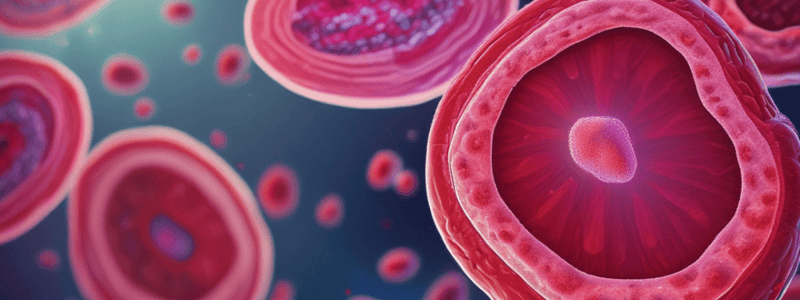Podcast
Questions and Answers
What is the purpose of the Direct Antiglobulin Test (DAT)?
What is the purpose of the Direct Antiglobulin Test (DAT)?
- To confirm the absence of antibodies in the bloodstream
- To demonstrate circulating antibodies in the serum
- To examine the repulsion forces between red blood cells
- To identify antibodies attached to red blood cells in vivo (correct)
What does a positive Direct Antiglobulin Test (DAT) indicate?
What does a positive Direct Antiglobulin Test (DAT) indicate?
- Antibody sensitization of red cells in vivo (correct)
- Insufficient antibodies on red cell surface
- Presence of circulating antibodies in serum
- Absence of globulin or complement molecules on red cells
In the Direct Antiglobulin Test, what is the function of Coomb's serum?
In the Direct Antiglobulin Test, what is the function of Coomb's serum?
- Detecting repulsion forces between red blood cells
- Inducing agglutination of sensitized red cells (correct)
- Washing the red cells with saline
- Demonstrating antibodies in the serum
What is the main difference between Direct Antiglobulin Test (DAT) and Indirect Coomb's Test?
What is the main difference between Direct Antiglobulin Test (DAT) and Indirect Coomb's Test?
What does a negative Direct Antiglobulin Test (DAT) imply?
What does a negative Direct Antiglobulin Test (DAT) imply?
Why is it necessary to centrifuge the red cell suspension in the Direct Antiglobulin Test?
Why is it necessary to centrifuge the red cell suspension in the Direct Antiglobulin Test?
What is the purpose of using a known antiserum in a test?
What is the purpose of using a known antiserum in a test?
Why should the sensitized red cells be checked against known, sensitized cells?
Why should the sensitized red cells be checked against known, sensitized cells?
What should be done to prepare check cells for the Coombs Test?
What should be done to prepare check cells for the Coombs Test?
What is a potential source of error that could lead to a false negative result in the Coombs Test?
What is a potential source of error that could lead to a false negative result in the Coombs Test?
What would be a consequence of using plasma instead of serum in the Coombs Test?
What would be a consequence of using plasma instead of serum in the Coombs Test?
How does under-centrifugation affect the Coombs Test results?
How does under-centrifugation affect the Coombs Test results?
What is the main reason why some IgG antibodies fail to agglutinate red blood cells?
What is the main reason why some IgG antibodies fail to agglutinate red blood cells?
How do the FAB portions of AHG molecules cause agglutination of sensitized red blood cells?
How do the FAB portions of AHG molecules cause agglutination of sensitized red blood cells?
Why are Coomb's serum antibodies necessary for the Direct Antiglobulin Test?
Why are Coomb's serum antibodies necessary for the Direct Antiglobulin Test?
What is the primary purpose of using AHG serum in testing for immune hemolytic reactions?
What is the primary purpose of using AHG serum in testing for immune hemolytic reactions?
In a Coomb's test, what is sensitized by attaching to red cell membranes?
In a Coomb's test, what is sensitized by attaching to red cell membranes?
What prevents small antibody molecules like IgG from producing agglutination directly?
What prevents small antibody molecules like IgG from producing agglutination directly?
Which of the following statements is true about the formation of ABO antigens?
Which of the following statements is true about the formation of ABO antigens?
According to Landsteiner's laws, which of the following statements is correct?
According to Landsteiner's laws, which of the following statements is correct?
Which of the following genes is associated with the formation of the A antigen?
Which of the following genes is associated with the formation of the A antigen?
Which of the following statements accurately describes the ABO antigens?
Which of the following statements accurately describes the ABO antigens?
Which of the following statements accurately describes the precursor oligosaccharide chains involved in the formation of ABO antigens?
Which of the following statements accurately describes the precursor oligosaccharide chains involved in the formation of ABO antigens?
According to Landsteiner's laws, which of the following statements is correct regarding the inheritance of ABO blood groups?
According to Landsteiner's laws, which of the following statements is correct regarding the inheritance of ABO blood groups?
What is the role of the H gene in the formation of ABO antigens?
What is the role of the H gene in the formation of ABO antigens?
According to Landsteiner's laws, which of the following statements is true?
According to Landsteiner's laws, which of the following statements is true?
What is the genetic basis for the Bombay phenotype?
What is the genetic basis for the Bombay phenotype?
What is the role of the A and B genes in the formation of ABO antigens?
What is the role of the A and B genes in the formation of ABO antigens?
What is the significance of the precursor oligosaccharide chains in the formation of ABO antigens?
What is the significance of the precursor oligosaccharide chains in the formation of ABO antigens?
According to Landsteiner's laws, which of the following statements is false?
According to Landsteiner's laws, which of the following statements is false?
What is the key difference between Type 1 and Type 2 precursor oligosaccharide chains?
What is the key difference between Type 1 and Type 2 precursor oligosaccharide chains?
According to Landsteiner's Laws, which of the following statements is true?
According to Landsteiner's Laws, which of the following statements is true?
Which of the following statements correctly describes the formation of the H antigen?
Which of the following statements correctly describes the formation of the H antigen?
Which of the following genes is responsible for the formation of the A antigen?
Which of the following genes is responsible for the formation of the A antigen?
What is the order of the amount of h-antigen present on red blood cells, from highest to lowest?
What is the order of the amount of h-antigen present on red blood cells, from highest to lowest?
Which of the following statements correctly describes the formation of the AB antigen?
Which of the following statements correctly describes the formation of the AB antigen?
Which of the following statements is true regarding the ABO antibodies?
Which of the following statements is true regarding the ABO antibodies?
Which gene is responsible for the absence of ABO antigens on red blood cells, resulting in the O blood group?
Which gene is responsible for the absence of ABO antigens on red blood cells, resulting in the O blood group?
Flashcards are hidden until you start studying




